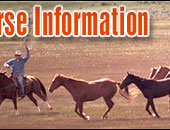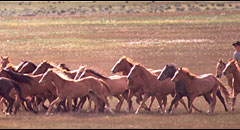 |
   |
|
|
|
You are here: Horses > Horse training > Horse Training Tips |
Horse Training Tips For Beginners and Young Horses
When starting to train a horse for the first time, it helps to have an
understanding of how horses think and react in the wild.
|
|
|
Horses are naturally herd animals. One stallion
generally is the head a herd of mares, but the “lead mare” determines the
direction the herd goes. Horses naturally fear other animals
and people, too. When you approach a horse, it does not have any way to know
what your intent is. It watches your actions and body language to decide its
response—flee, or stand and wait. |
This can help you understand why training needs to be a gradual process of
getting your horse’s attention and then teaching it what to do. Your horse,
ideally, should see you as its lead mare, regardless of the gender of its owner.
If your horse is a natural leader, however, you will often find training to be
quite a challenge!
Instinctually, horses want a leader to show them how things are and what to do.
This is part of being a herd animal. Naturally, we want you, the human, to be
the leader. A horse will recognize you as the leader either from fear or
respect. Your interactions and relationship with your horse will be more
satisfying for both of you if you lead by earning your horse’s trust and
respect.
Usually, a horse will not begin formal training until it is around two years
old. However, foals are able to learn how to behave around people from a very
early age. It is important to spend as much time as you can with your young
horse so it will become used to being around you, and by extension, other
people.
Once your horse is old enough to start training, you must use ground work before
ever attempting to ride. Longeing, or ground training with a long rope, is the
first step. The longe line attaches to the horse’s halter and allows it a large
circle of movement while you teach it commands.
Another absolutely necessary thing to teach your horse is how to walk beside you
on a lead. Lead training, which also includes teaching it to turn and stop at
your command, is vital and you will use it almost daily with your horse. Many
horses will ‘test’ you during lead training by attempting to shoulder you out of
his space. Don’t let him get away with it! If he can resist this very simple
training, future training will be that much more difficult.
Horses are trained so they will accept being ridden, and follow the signals of
their riders. Your horse needs to respond when you ask it to do something
because it is well trained. This prevents the need for whips or crops to punish
or encourage the horse to do what you want.
There is no hard and fast rule about how much time a training session should
take.
The first part of the training session is used to warm up the horse, both
mentally and physically. This time allows it to loosen its joints and warm its
muscles. Longeing is a typical method of warming up.
Next, you should practice those things the horse already knows before
introducing something new. Any new skill should be just a tiny alteration on
something the horse already knows. Building on previously attained skills is the
key to successful training.
If you add a new piece of equipment, take it back off after just a few minutes.
Repeat this for a few days, allowing your horse to get used to it. Then let the
horse wear it during longeing. Once he is accustomed to wearing a saddle, have
someone sit on him briefly as he stands still. Work up to longeing with a rider.
Add new things just a small amount at a time.
Another example of something to add gradually is a bit. A young horse must learn
to accept a bit as something normal and natural to have in its mouth, and this
won’t happen overnight. The horse must learn how to swallow saliva with a
foreign object in its mouth. To facilitate this, a trainer will slowly introduce
a mouthing bit, for just a few minutes at first and slowly building, until the
horse no longer objects to it.
The saddle should likewise be introduced slowly. The stirrups and leathers
should be removed initially. Allow your horse to see the saddle, then just hold
it over him, not touching him, until he loses his fear of it. The first time you
place the saddle on your horse, be ready to do a lot of reassurance and
stroking. Next time, introduce the girth, then the leathers and stirrups. Add
each new thing when your horse has lost his fear of the last new thing.
Lastly, all training sessions must end with a cool down period. This allows the
horse to mentally and physically wind down and relax. Ideally, the cool-down
period should begin when the training has been going well, and before your horse
becomes frustrated or tired. You want your horse to remember pleasant things
about training and ending positively facilitates this. Let your horse play for a
bit, and then return him to the stable or pasture.
Finally, remember that your horse will take its cue from you. If you are calm
and unafraid, so will your horse feel. If you move, your horse interprets this
as a change of direction from its lead mare and will move, too. Once your horse
understands your body language, he will naturally follow your lead.
|
Read the next horse training article on
Horse Lead Training. |
|
|
|
|
 |
|
|
 |
 |
  
Visit Equestrian Cupid now.
The best and largest equestrian club for meeting the other half for friendship and marriage
|
|
 |
|
|
|
Horse Education
|
|
|
|
|
Horse Information Topics
|
|
|
|
|
|
|
|
Horse Business Owners
|
| |
Advertise with Us
Have your horse products or services exposed to over 27,000 of our monthly visitors.
|
|
|
|
|
|